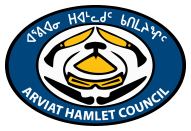Geographical Coordinates: 61°06′29″N 094°03′25″W
Elevation: 10 m (33 ft)
Population: 2851
Average Temperature (July): 10C
Average Temperature (January): -25C
History of Arviat
The history of Arviat begins with the Inuit. They have inhabited this area for thousands of years. Inland Pallirmiut were known to be excellent traders.
They travelled throughout the region to acquire goods to exchange with other groups. By the mid 1800’s they were known as skillful middlemen. Obtaining furs and ivory further north, they took advantage of their seasonal travel to hunt seal, whales, and walrus by the coast to trade with Hudson Bay Company’s ships docked at Eskimo Point.
This fruitful activity led in 1921 to the establishment of a permanent trading post. Shortly thereafter, in 1924, the Roman Catholic Mission set up a little church on the ridge on the way to Nuvuk (the Point). In 1926, the Anglican church followed suit and established their mission at Arviat. By then, the migration of caribou herds were shifting, prices of furs weak, therefore many Inuit faced starvation. More people started to aggregate around the small outpost seeking relief and medical help provided by the churches. The permanent deployment of Royal Canadian Mounted Police in 1937 offered further stability and a visible presence of the government’s support.
A famine in the 1940’s, accompanied by epidemics of tuberculosis and diphtheria disseminated families. The federal government acted quickly to relocate Inuit from different areas to Arviat. Many Inuit were relocated against their will. After the relocation, some chose to return to the land of their ancestors seasonally.
A federal school was constructed in 1959. This, along with improved health care and social benefits, encouraged families to live year-round in the settlement. Eventually the Alliance mission closed its school at the mouth of the Maguse River and moved to the community.
